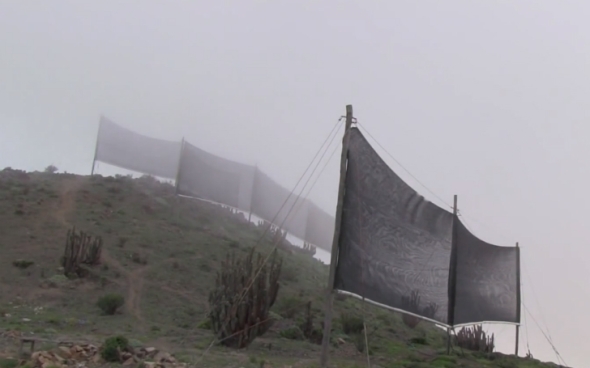Lean Water: Applying Lean Thinking to Our Coming Water Shortage
Posted: September 5, 2018 Filed under: Leadership, Organizations and Sectors of Interest | Tags: decentralization, lean, Lean Six Sigma, lean thinking, water security 1 Comment
There has always been a to-and-fro between the Malthusian, limits-to-growth school of thought that sees the growth in human population and its increasing consumption as out-stripping the carrying capacity of the planet, and the innovation and technology-focused thinking that emphasizes the ability of new, often unforeseen technologies erasing those limits.
It is with this in mind that I read a recent story about plans to harvest drinking water from the mists and fogs that roll in from the ocean off of Chile’s drought-plagued central regions.
Los Tomes is an agricultural co-operative, one of 178 in Chile’s Coquimbo region. Nineteen comuneros try to grow wheat and raise sheep and goats on 2,800 hectares (7,000 acres) of semi-arid scrubland. A decade-long drought has made that harder. Hilltop springs where the animals once drank have dried up. As herds shrank and yields fell, farmers’ children moved away to take jobs in cities or at copper mines.
Hope for Los Tomes comes in the form of three 60-square-metre (646-square-foot) nets stretched between poles on a ridge above the community. These atrapanieblas capture droplets from the fog that rolls in from the sea 4km (2.5 miles) away. They trickle down to a pipe, which channels the water to two troughs at the foot of the ridge, from which livestock drink. The banner-like nets can harvest 650 litres (140 gallons) of water a day. “We’re content: it’s produced the results we wanted,” says José Ossandón, the child’s father and the president of the co-operative.
Chile has been investigating fog capture since the 1950s. The dense fog that arises from the Humboldt current, called the camanchaca, can be harvested with the help of a coastal mountain range and strong winds. Earlier attempts to turn the mist into usable water failed. In 1990 fog nets at Chungungo, a fishing village north of Los Tomes, captured 8,000 litres a day. Villagers argued about how to share responsibility for maintaining the atrapanieblas.
Climate change, which is expected to decrease rainfall in the region, has spurred a new quest for unconventional sources of water. The project at Los Tomes is part of an attempt to revive fog capture by encouraging better governance. A government development fund has put up cash. A team from the Catholic University of the North (UCN) sought out agricultural co-operatives whose members have shown that they can work together. “The question is not whether the fog collectors work but who’s going to provide and maintain them,” says Daniela Henríquez, a sociologist who leads the UCN team.
At Majada Blanca, a goat-herding community north of Los Tomes, three 150-square-metre fog catchers feed a plantation of young olive trees, a splash of green in the brown scrub. When the trees mature they will produce 750 litres of organic olive oil a year, which the comuneros will be able to sell for about $12,000. A privately owned brewery in Peña Blanca was quick to spot fog water’s marketing appeal. It is the main ingredient of its artisanal beer, called Atrapaniebla.
It makes a profit, but most fog-harvesting projects require subsidies in their early stages. The development fund paid 5.6m pesos apiece to put up the structures at Majada Blanca; when the nets wear out, the villagers will have to replace them at a cost of 100,000 pesos each. Coquimbo has more than 40,000 hectares of land with the right conditions for putting up fog-catchers. If it were fully exploited, the region could harvest 1,400 litres a second, enough to supply all its drinking water. (The Economist, June 16, 2018)
Approaches such as this are certainly worth considering, as are many other desalinization, capture, reduction and re-use techniques.
But like electricity production, which is ever so slowly decentralizing as technology matures, so too is much of the new thinking on how to better capture and use that most elemental of “commodities,” fresh water.
In his excellent book, Water: The Epic Struggle for Wealth, Power and Civilization, Steven Soloman writes:
The age of water scarcity consequently heralds the potential start of a momentous transition in the trajectory of water and world history: from the traditional paradigm based on centralized, mass-scale infrastructure that extracted, treated, and delivered ever greater, absolute supplies from nature to a new efficiency paradigm built upon more decentralized, scaled-to-task, and environmentally harmonious solutions that make more productive use of existing supplies. (Steven Solomon. Water: The Epic Struggle for Wealth, Power, and Civilization p. 369)
This is Lean Thinking writ large: the focus on decentralized, front-line-driven efforts and experiments; the elimination of all forms of waste; the emphasis on practical, robust technologies and approaches that are adaptable and as simple as possible.
But just as in the public sector and in business, the biggest challenge will be to wrest control from centralized power structures that command and control things including water and energy. To be sure coordination and data sharing is vital, but that is a far cry from command and control executives, agencies and departments.
Water is but one example of how Lean Thinking will need to move rapidly from a business-technical construct to a sociopolitical idea.
